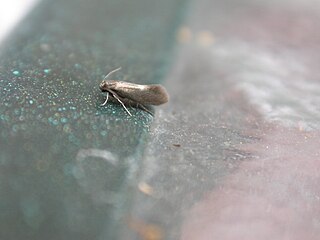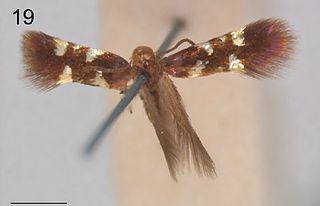| Holocacista pariodelta | |
|---|---|
| Scientific classification | |
| Kingdom: | Animalia |
| Clade: | Euarthropoda |
| Class: | Insecta |
| Order: | Lepidoptera |
| Family: | Heliozelidae |
| Genus: | Holocacista |
| Species: | H. pariodelta |
| Binomial name | |
| Holocacista pariodelta (Meyrick, 1929) | |
| Synonyms | |
| |
Holocacista pariodelta is a moth of the family Heliozelidae. It was described by Edward Meyrick in 1929. It is found in India. [1]

Moths comprise a group of insects related to butterflies, belonging to the order Lepidoptera. Most lepidopterans are moths, and there are thought to be approximately 160,000 species of moth, many of which have yet to be described. Most species of moth are nocturnal, but there are also crepuscular and diurnal species.

A family of primitive monotrysian moths in the order Lepidoptera, Heliozelidae are small, metallic day-flying moths with shiny smooth heads. In Europe the small adult moths are seldom noticed as they fly quite early in the spring. The larvae are leaf miners and the vacated leaf mines are distinctive because the larva leaves a large hole at the end.
Edward Meyrick FRS was an English schoolmaster and amateur entomologist. He was an expert on Microlepidoptera and some consider him one of the founders of modern Microlepidoptera systematics.
The larvae feed on Lannea coromandelica . They mine the leaves of their host plant. [2]

Lannea coromandelica, also known as the Indian ash tree, is a species of tree in the family Anacardiaceae that grows in South and Southeast Asia, ranging from Sri Lanka to Southern China.. Its commonly known as Gurjon tree and is used in plywoods for its excellent termite resistance properties. It most commonly grows in exposed dry woodland environments, where the tree is smaller and more crooked. In more humid environments it is a larger spreading tree that can become 20 meters tall. In Sri Lanka Lannea coromandelica often grows on rock outcrops or inselbergs.

A leaf miner is the larva of an insect that lives in and eats the leaf tissue of plants. The vast majority of leaf-mining insects are moths (Lepidoptera), sawflies and flies (Diptera), though some beetles also exhibit this behavior.






